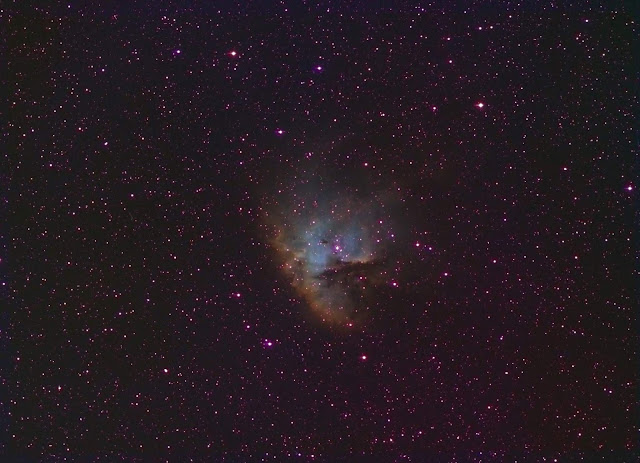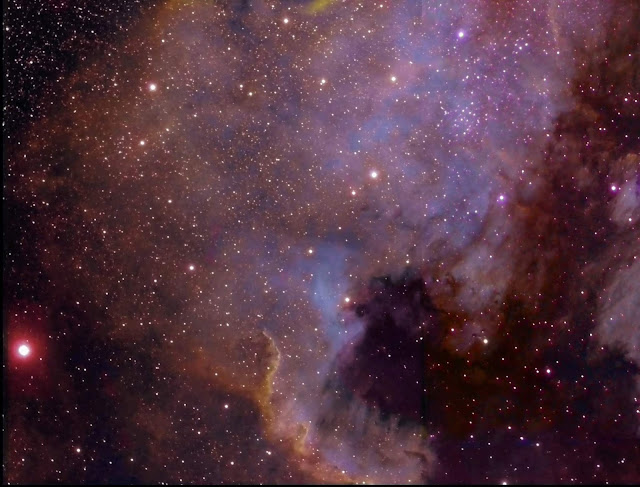NGC 281. This bright nebula lies in the constellation of Cassiopeia the Queen. I was using my 80mm f/6.3 refractor , a Vixen Atlux mount, an Atik 383L mono CCD camera and a set of Astronomik narrowband filters, HA, S11 and O111 . The total exposure time was 5 hours using the HA filter. 1 hour using the S11 filter and 1 hour using the O111 filter. I captured ten minute sub frames with matching dark frames and combined them with flat field frames to reduce the effect of vignetting in the final image.
RGB
Hubble palette
Bicolour
IC63 . This patch of faint nebulosity lies in the constellation of Cassiopeia the Queen. I used my 80mm f/6.3 refractor, a Vixen Atlux mount with PHD auto guiding, an Atik 383L mono CCD camera and a set of Astronomik narrowband filters. I captured ten minute sub frames combined with dark frames and flat field frames to reduce the effect of vignetting in the final image. The total exposure times was three hours using a H Alpha filter, one hour using a O111 filter and one hour using a S11 filter.
Narrowband RGB
Narrowband Hubble palette
Narrowband Bicolour
The Elephant trunk nebula. This nebula lies in the constellation of Cepheus the King. This wide angle image was taken using my 80mm f/6.3 refractor with a Vixen Atlux mount, PHD auto guiding, an Atik 383L mono CCD camera and a set of Astronomik narrowband filters. I captured ten minute sub frames with matching dark frames and combined them with flat field frames to reduce the effect of vignetting in the final image. The total exposure times was three hours using a H Alpha filter, one hour using a S11 filter and one hour using an O111 filter. The other image however is a composition using three different telescopes, a Ten inch f/4.8 reflector, a four inch f/6.3 refractor and a 80mm f/6.3 refractor. The total exposure time was ten hours.
IC1396
Using 3 scopes
NGC7000 The North American nebula. This lies in the constellation of Cygnus The Swan. This image was taken under full moon light, stars only visible down to magnitude 3.2. I used my f/6.3 80mm refractor, an Atik 383L mono CCD camera, A Vixen Atlux mount with a set of Astronomik narrowband filters. I captured ten minute sub frames with matching dark frames and combined them with flat field frames to reduce the effect of vignetting in the final image . the total exposure times was one hour using a H Alpha filter 40 minutes using an O111 filter and 40 minutes using a S11 filter.
RGB
Bicolour
Hubble palette
The Pelican nebula, IC5070. This patch of nebulosity lies in the constellation of Cygnus the Swan right next to NGC7000 the North American nebula. I was using my 80mm f/6.3 refractor, a Vixen Atlux mount, PHD auto guiding, an Atik 383L mono CCD camera with a set of Astonomik narrowband filters. I captured ten minute sub frames with matching dark frames and flat field frames. The flat field frames reduces the effect of vignetting in the final image . The total exposure times was 60 minutes for each filter, HA, S11 and O111
North American and Pelican nebulae
Pelican nebula
Pelican nebula Hubble palette, three scopes
IC1848 The Soul Nebula. This lies in the constellation of Cassiopeia the Queen. This image was taken under very clear sky conditions with stars visible down to magnitude 5. The telescope I was using was my 80 mm f/6.3 refractor with an Atik 383L mono CCD camera. The mount I used was a Vixen Atlux mount with PHD auto guiding. The filters was a set of Astronomik narrowband filters H Alpha, O111 and S11. The total exposure times was 60 minutes for each filter capturing ten minute sub frames with matching dark frames with flat field frames reducing the effect of vignetting.
Hubble palette
IC1805 The Heart Nebula. This lies next to the Soul Nebula in the constellation of Cassiopeia the Queen. I used my 80 mm f/6.3 refractor, a Vixen Atlux mount, PHD auto guiding, an Atik 383L mono CCD camera and a set of Astronomik narrowband filters, HA, S11 and O111. I captured ten minute sub frames with matching dark frames and combined them with flat field frames to reduce the effect of vignetting in the final image. The total exposure times was one hour for each filter.
Bicolour
Hubble palette

















